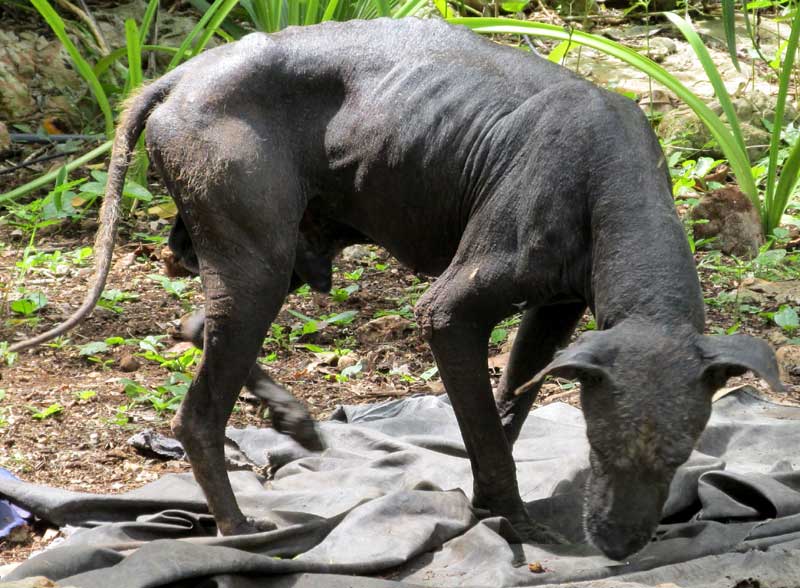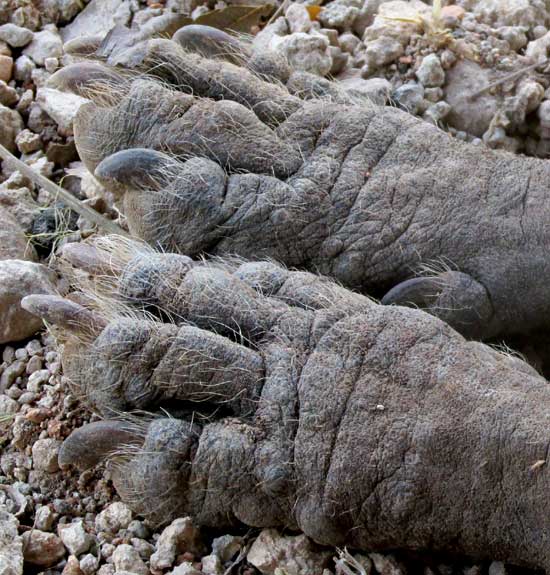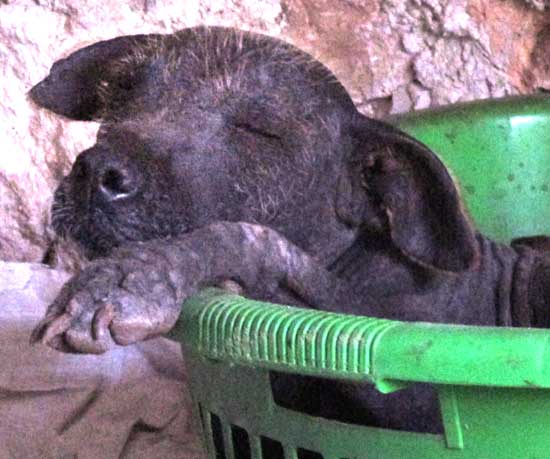Excerpts from Jim Conrad's
Naturalist Newsletter
from the October 2, 2016 Newsletter issued from Rancho Regenesis in the woods ±4kms west of Ek Balam Ruins; elevation ~40m (~130 ft), N20.876°, W88.170°; north-central Yucatán, MÉXICO
XOLOITZCUINTLE, MEXICAN HAIRLESS DOG
Among the dogs who excitedly greeted me when I arrived at Rancho Regenesis was one that was probably the ugliest canine -- in conventional thought -- I've ever seen. He was almost completely hairless, and his black skin was rough and hot to the touch. At first I thought he had the mange, but after feeling how hot he was I figured he was sick and the high fever had made his hair fall out. That's him below:

After several days his condition hadn't changed, and in fact he didn't seem sick at all. And then it dawned on me: He was a Xoloitzcuintle, a rare, famous dog breed sometimes known as the Mexican Hairless Dog. The name Xoloitzcuintle is from the Nahuatl language spoken by the ancient Aztecs, and still spoken in much of the Mexican highlands. The local Maya use that name, however, suggesting that maybe the breed was introduced here from the Mexican uplands.
Xoloitzcuintles (CHO-lo-eetz-QUEENT-les) have been documented as existing 3000 years ago. The Aztecs and their ancestors believed that Xoloitzcuintles could accompany and guide them to the netherworld when they died, so at human funerals the dogs were ceremoniously killed and buried with their owners. The breed is also famous for being eaten by indigenous people, regularly in the past, but only spottily nowadays. And I've read that in the past Xoloitzcuintles slept with their owners, their high body temperatures providing heat on cold nights, especially for the feet.
Our Xoloitzcuintle -- his name is Chichan Ch'o', meaning Little Rat, because that's what he looked like when he was born -- seems to be of pure stock, because his features match exactly the description given for the breed on the Internet. First, he's not completely hairless, since the breed's hairlessness is programmed on a single gene, and that gene is only partially dominant. Chichan Ch'o', as is typical of the breed, bears sparse hair at the base of his tail, and on the crown of his head, as seen below:

The Xoloitzcuintle's hairless, wrinkled paws are known to be especially tender and problematical, and it's true that Chicha Ch'o' spends a lot of time licking and chewing between his toe pads, and sometimes seems to find walking unpleasant.
The hot body temperature also is normal, apparently an adaptation for its hairless condition. The breed's normal body temperature is given as 40°C, or 104°F, so if you've felt the forehead of a child with a 104°F fever, you know how it feels to touch Chichan Ch'o', except that dogs don't sweat, so theirs is a dry heat.
The Spanish Wikipedia page for Xoloitzcuintles says that they are intelligent dogs, but Chichan Ch'o' strikes me as a bit dumb. He spends lots of time staring at things, including stone walls. Sometimes as he's looking at a wall or a table his tail alternately droops and vigorously wags, as if he's seeing something interesting. When a female Xoloitzcuintle was brought to him, he got excited, but couldn't figure out what to do. Among the three dogs running free at the Rancho, Chichan Ch'o' is the lowest ranked, the omega dog. But if a breed is developed mainly for being killed at funerals, for keeping the feet warm, and for eating, it doesn't need much intelligence -- just a willingness to go along with whatever happens, and that seems to be Chichan Ch'o''s temperament exactly. He likes to eat bananas, by the way, even just the peelings.
An interesting feature of Xoloitzcuintle genetics is that there are two forms -- the hairless one like Chichan Ch'o', and a hairy one. The hairy condition is recessive. Inheritance of the hairless and and hairy states follows classic Mendelian genetics. If hairless (dominant) and hairy (recessive) individuals mate, 50% of the offspring will be hairless and 50% hairy. If two hairless individuals mate, 50% of the offspring will be hairless, 25% hairy, and 25% will die before birth because having only the recessive gene is lethal.
from the May 28, 2017 Newsletter issued from Rancho Regenesis in the woods ±4kms west of Ek Balam Ruins; elevation ~40m (~130 ft), N20.876°, W88.170°; north-central Yucatán, MÉXICO
XOLOITZCUINTLE UPDATE
Since writing the above section I've learned a lot more about Chichan 'Cho' and the Xoloitzcuintle breed. For instance, something they're famous for is having large, wrinkled feet, as seen below:

Also, they seem to adapt very well to human households. Few things please Chichan 'Cho' more than lying next to me as I work, and sleeping as close as he can to me at night. He has a basket to sleep in and that's his favorite place. Below, you can see his snoozing posture

Chichan 'Cho' snores and farts like a fat man, and what's even funnier -- and I don't know if it's typical of the breed or just to him -- when he gets excited, as when a visitor arrives, he grins broadly, which causes him to sneeze repeatedly. Below, you can see him in the midst of a frenzy of sneezing:

That picture shows another feature typical of the breed: They have bad teeth. You can see that not only are his teeth very irregularly formed and spaced, but also his long, sharp biting teeth, his canines, have fallen out. Chichan Ch'o' can't eat tough flesh like a regular dog, and for that reason villagers often say that the breed is vegetarian. Chichan Ch'o' seems happy to eat banana peels and cut-off papaya husks, and gets very excited when offered a tortilla. Why would Xoloitzcuintles habitually have bad teeth? One guess is that ancient dog breeders, thinking in terms of sleeping with them, might have preferred sleeping companions lacking fangs, and thus bred them for that feature.
The lack of canine teeth and dense fur puts Xoloitzcuintles at a severe disadvantage during dogfights. Chichan Ch'o' loses every tussle he gets into. Even the rancho's cats send him running and yelping with a few swipes of their paws. Keeping this in mind, here's a story to make the point that the breed, or at least Chichan Ch'o', is exceptionally loyal to the master.
A few months ago when I passed by the rancho's dogs as they were being fed I noticed that the aggressive, schizophrenic watchdog known as Sombra left his own food, walked over and pushed Chichan Ch'o' from his dish and began eating there. I'd never had problems with Sombra so with my leg I tried to nudge the bowl back to Chichan Ch'o'. Sombra sank his fangs into my leg (I was wearing shorts), let go and bit again, let go, and took another bite. I'll have six conspicuous puncture wound scars on the back of my right leg for the rest of my life. Anyway, despite Chichan Ch'o''s inability to fight, while Sombra was hanging onto my leg for the third time, Chichan Ch'o' attacked Sombra, knocking him off. Immediately Sombra's fangs were in Chichan Ch'o''s back, but this gave me time to get a pole and knock the heck out of Sombra. So -- loyal dog.
Living with a Xoloitzcuintle is almost like having a little clown in the household, and it's always nice to have a loyal friend nearby. Still, I'd not advise anyone to encourage the breed's dispersal. That's because these dogs suffer in ways other dogs don't. Being unable to defend themselves in dogfights, they always have low status in any pack that forms. Without coats of hair, once the temperature drops below about 60°F (15°C), they shiver pitifully. Also, with those bad teeth, frequently they have toothaches. A while back the whole side of Chichan Ch'o''s face swelled up, until a tooth came out. And those big feet seem particularly vulnerable to infections. Despite the use of many antibiotic ointments, poor Chichan Ch'o' spends as much time gnawing and chewing at his paws as regular flea-bitten dogs spend scratching themselves.